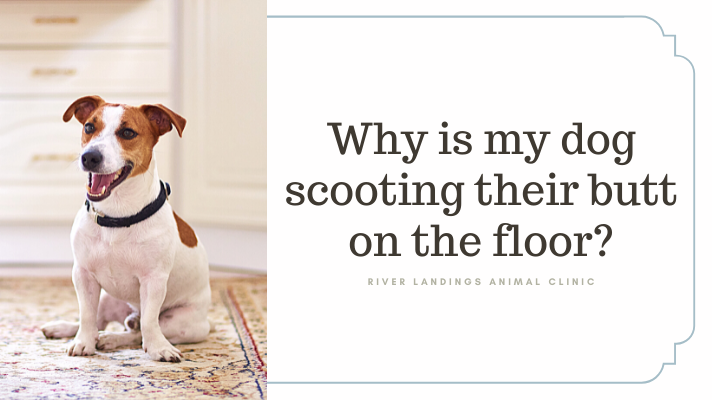Have you ever watched your beloved dog do a little dance across the floor, dragging their bottom along the carpet? It’s a sight that can be both humorous and unsettling. While it might look like a playful maneuver, that scooting behavior often signals something more – an uncomfortable truth about your dog’s rear end.

Image: mromavolley.com
But fear not, dear pet parent! Understanding why dogs scoot can help you decipher whether it’s a harmless quirk or a symptom of a bigger health issue. This article will delve into the world of canine derrières, exploring the reasons behind this peculiar behavior and offering insightful tips to ease your dog’s discomfort.
Unraveling the Mystery Behind the Scoot
Let’s start with the basics. When a dog scoots, they are essentially trying to alleviate an itchy, irritated, or uncomfortable feeling around their anus and/or the base of their tail. This discomfort can stem from various factors, ranging from simple annoyances like dirt and debris to more serious conditions requiring veterinary attention.
The Most Common Culprits
- Anal Gland Issues: Anal glands, located on either side of a dog’s anus, secrete a foul-smelling liquid that plays a role in communication and territorial marking. When these glands become impacted or infected, it can cause irritation and pain, leading to scooting.
- Parasites: External parasites like fleas, ticks, and mites can infest the area around the anus, causing intense itching. This discomfort can trigger frequent scooting and leave your dog feeling miserable.
- Allergies: Skin allergies are another potential culprit. Dogs can react to allergens like pollen, dust mites, and food, resulting in itchy, red, and inflamed skin. When these allergies affect the anal area, scooting becomes a common symptom.
- Diarrhea or Constipation: Frequent bouts of diarrhea or constipation can irritate the sensitive area around the anus, making your dog want to scoot to relieve the discomfort.
- Trauma or Wounds: Injuries, cuts, or abrasions in the anal region can lead to pain and itching, prompting your dog to scoot.
- Dietary Issues: Some dogs are sensitive to certain ingredients in their food, leading to digestive upset and skin irritation. If you suspect your dog’s diet might be contributing to their scooting, consult your veterinarian about a possible food allergy.
- Tumors: While less common, anal gland tumors can also cause itching, pain, and scooting.
Decoding the Scooting Signals
Understanding the frequency and severity of your dog’s scooting can offer valuable clues about its underlying cause:
- Infrequent Scooting: Occasional scooting, especially after a bowel movement, could be normal. However, frequent episodes might be a sign of an underlying issue.
- Scooting and Excessive Licking: If your dog is seen both scooting and excessively licking their rear end, it’s crucial to pay close attention. This behavior often points to an itchy or irritated anal area.
- Scooting with Blood: If you notice blood around your dog’s anus or in their stool, it’s a serious concern. Seek immediate veterinary attention, as it could signify internal bleeding or other health problems.

Image: animalia-life.club
Seeking Veterinary Guidance for Relief
If your dog’s scooting behavior seems persistent or accompanied by other symptoms, it’s crucial to visit your veterinarian. They can conduct a physical examination, perform necessary tests, and analyze stool samples to pinpoint the root cause of the issue.
A Comprehensive Approach
Once the underlying cause is identified, your veterinarian can recommend the appropriate treatment plan. This might involve:
- Anal Gland Expression: In cases of impacted anal glands, your vet can manually express the glands to relieve pressure and discomfort.
- Parasite Treatment: If parasites are detected, your veterinarian will prescribe medication to eliminate them.
- Antibiotics: If an infection is present, antibiotics may be necessary.
- Anti-Inflammatory Medications: For inflammatory conditions, your veterinarian might recommend anti-inflammatory drugs to reduce swelling and discomfort.
- Dietary Changes: If food allergies are suspected, your veterinarian can guide you on switching your dog to a hypoallergenic diet.
- Surgery: In rare cases, tumors or other serious conditions might require surgery.
Home Remedies to Soothe the Itch
While home remedies can’t replace veterinary care, they can help soothe your dog’s itch and discomfort:
- Warm Compress: Applying a warm compress to the affected area for a few minutes can provide temporary relief from itching.
- Oatmeal Baths: Oatmeal is a natural anti-inflammatory agent. Adding colloidal oatmeal to your dog’s bath can help soothe irritated skin.
- Cleaning the Area: Gently cleaning the anal area with warm water and a mild dog-safe shampoo can help remove irritants and prevent infection.
- Proper Grooming: Regularly brushing your dog’s coat can help prevent the accumulation of dirt and debris that could irritate their anus.
Preventative Measures and a Life of Comfort
Preventing anal gland issues and other skin problems can go a long way in keeping your dog comfortable and happy:
- Regular Anal Gland Expression: Consult your veterinarian about the frequency of anal gland expression for your dog. Regular expression can prevent impaction and discomfort.
- Parasite Prevention: Utilize flea and tick preventative medications to keep your dog free from these pesky parasites.
- Balanced Diet: Feed your dog a high-quality diet formulated for their age and breed.
- Proper Hygiene: Maintain a clean and hygienic environment for your dog, including regular bathing and grooming.
Why Dogs Scoot Their Buts On The Floor
Conclusion: A Scoot-Free Future
Scooting isn’t something your dog enjoys. It’s a sign of discomfort, and it’s important to understand why the behavior occurs to address it effectively. By following the advice in this article and consulting with your veterinarian, you can help your dog live a life free from the uncomfortable “scoot.” Remember, a healthy, happy dog is a scoot-free dog!






